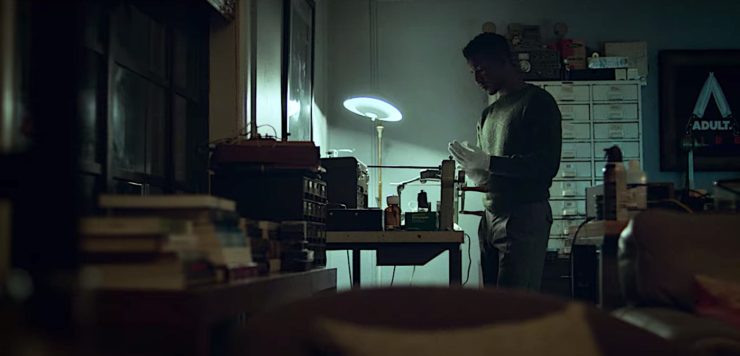First things first: Archive 81 is fun as hell, most of the time, and reliably creepy. The writers and directors went all-in on atmosphere and mounting dread, and rely on horror to grow out of psychological terror rather than gore. There is almost no physical violence in this show? The horror plot reminded me more than anything of an old-timey 1930s haunted house movie, which is exactly what I wanted to watch over a freezing winter weekend.
The show opens on a wide shot of the Flatiron Building, one of my very favorite buildings in New York, where I worked for over six years, and then the main character takes the R train to the Museum of the Moving Image, the place where I spent the vast majority of my summers for about five years. I was not expecting to feel so many emotions in the first five minutes of the fun horror show!
There are three main threads here. First, obviously, is the horror plot. A mysterious corporation hires film archivist Dan Turner (Mamoudou Athie) to restore some videotapes that were shot in 1994. The tapes were nearly destroyed in a fire that, presumably, killed their creator, Melody Pendras (Dina Shihabi). As Dan restores the tapes, he begins to feel an uncanny connection to Melody, learns that the shadowy corporation is (surprise!) hiding a secluded-mountain-compound’s worth of nefarious secrets, and starts to uncover the truth about a cult.
Generally, each episode opens with a piece or artifact that comments in some way on what’s to come. The show hops between the present day (either New York City or a compound in the Catskills where Dan is restoring the video) recordings, or back to what’s on the recordings themselves (in which NYU student Melody tries to interview the residents of the Visser Apartments in 1994 New York City). As the plot unspools, the lines between present and past blur, as do the lines between natural and supernatural.
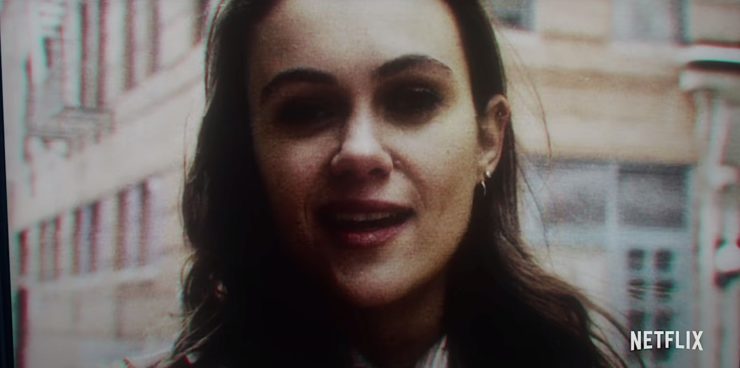
This sounds pretty standard issue, but where the show makes itself unique is in thread two: a visceral love/hate relationship with film and recording. As I mentioned, Dan is film archivist. He works at the Museum of the Moving Image (which, if you haven’t been, and if you happen to be in New York once it’s safe to do things again, go. It’s one of my favorite places in the world, and I miss the hell out of it.) and we see him at his work, carefully scraping gunk from reels of film, swabbing tapeheads, wielding q-tips and isopropyl alcohol like he’s a surgeon in an operating theater.
Can I express the thump I felt in my chest each time he tended to a tape or a reel of raw film? The show makes the film restoration a motif, and it also plays with different types of recording: the grainy black and white stock of a 1960s BBC series, the thin tape of Melody’s 1990s Sony camcorder, the cassettes of a Fisher Price kids’ video recorder from 1987, the perilously fragile spool of film from 1924. All of these tactile recordings are set up as a contrast with the hypermodern equipment Dan’s using, both the soulless, ephemeral computer files and the constant, cold digital surveillance as every computer screen and flat TV hides a camera watching his every move.
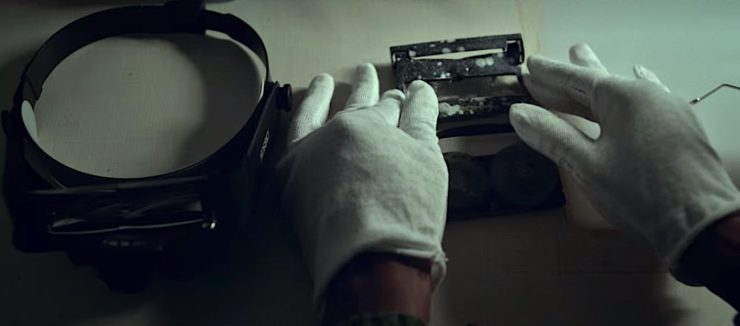
But it’s not even just the wonkery of restoring physical media—the main characters of this show love film. They decorate with film posters. There are loving monologues about Ray Harryhausen’s work. Characters wear T-shirts celebrating Kim’s Mondo Video AND Rooftop Films. When Dan needs his friend to pick something up from his apartment, he tells him “The keys are in the Tarkovsky mug.” The Tarkovsky mug!
And it’s more than that even, because the show is structured around the physical media. We’re eased into the past along with Dan by watching the recordings, then the episode opens up and we’re there in 1994 with Melody and the residents of the Visser. The show is generally pretty good about checking in with the camera to show that, yes, Dan is still watching some version of the events we’re seeing. As with The Blair Witch Project, this creates a bit of plausibility around why we know what we know, but it also leads to a couple moments where you’ll probably say something along the lines of “put the fucking camera down and RUN”—but it also makes the slow burn of Dan’s connection to Melody work really well. For a show like this to feel true, you have to buy that two characters can reach each other across time, and by about episode three, I was all in on the idea that Dan and Melody would have been friends if they’d met in life.
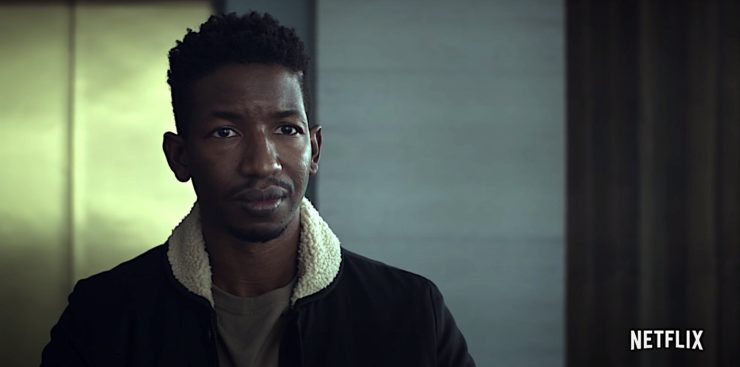
Which brings us to thread number three! Sometimes you just love a character, and want to reach through the screen and hug him, and make everything okay. Dan is one such character. (One of my only ongoing issues with the show was that I didn’t like worrying about him, which made watching him cope with a horror plot a little difficult.) Athie is brilliant at shading between Dan being a depressed mess, being maybe a bit obsessed with his work, and panicking that he might be losing his mind.
And what’s excellent is that thread three focuses on Dan’s friendship with a film freak/podcaster named Mark. I feel like it’s still fairly rare to see nuanced male friendships onscreen, so watching how Mark shows up for Dan even though he can be a prickly bastard sometimes, and watching Dan work through his own issues to trust Mark more—it really hit me hard to watch that unfolding in a show that is, primarily, a scary story to tell in the dark. And then to have that friendship mirrored in the deep love between Melody and her BFF-possibly-with-benefits Annabelle? The show continually does more than it needs to in order to show how important these bonds are to the characters, and it makes for a nice undertone as we watch Dan connect to Melody over her tapes.
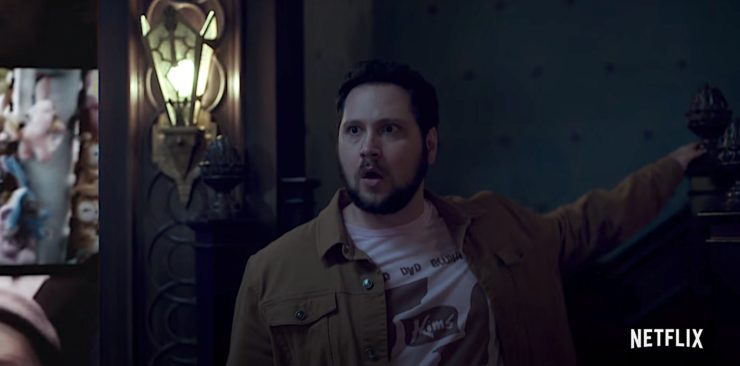
As for the horror, the claustrophobia and solitude of the Catskills compound is very well done. I do also recommend watching with the lights off, as there’s some great use of deep shadow, mirrors, faces in TV screens, etc. that will pop a lot better in the dark. The show makes allusions to everything from The Shining to The Omen to Rosemary’s Baby to Don’t Look Now to Solaris to Silent Hill, but never in a way that turns into a reference factory. The riffs are there for horror fans, but they’re not a barrier to a more casual viewer.
I think there’s a lot of X-Files DNA here, too—at one point, Dan murmurs “It’s me” to Mark on the phone, sounding for all the world like Fox Mulder talking to Scully, the one and only person he’s ever trusted. Like Mulder, Dan is exactly as paranoid as he should be: He does his best to keep his internet profile minimal, and he operates with the knowledge that somewhere, there is always a camera recording. (For our current purposes, it’s the one in the computer you’re using to read this.)
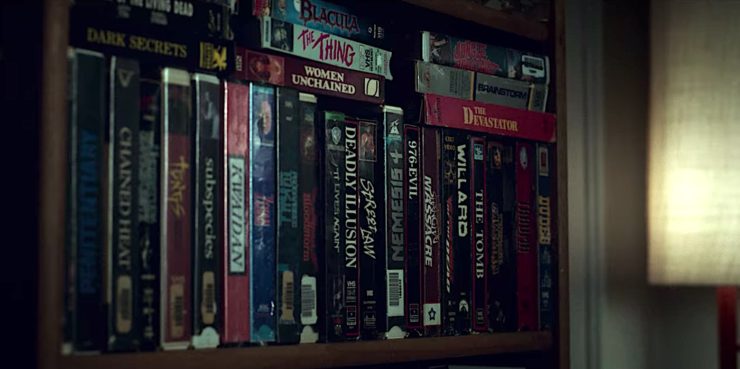
Archive 81 gets the ‘90s right, too, in the same way that Tick..Tick… Boom! recently did. People are wearing oversized tie-dyed shirts, ratty flannels, high-waisted lightwash jeans, dark lipstick, chokers—but it all looks cheap and lived-in, not costume-y. The building’s Elder Lesbian still keeps up the pretense that she and her partner were sisters, because when they moved into the building they had to pass, and even by the ‘90s in New York it wasn’t always safe to be openly queer. (The gap between her behavior and, say, Melody’s friend Annabelle’s, who is brash and open about everything, is an interesting bit of detail.) The one ding, though, is that Melody is a jobless grad student, who moves into an apartment building full of artists, tarot readers, retirees, a Columbia professor, but even in 1994, how is anyone paying their rent? I mean, Rent was literally being workshopped a few blocks away in the year this takes place, and it was about a much shittier building—was there a discounted two-year lease if you joined the cult? And if so, are there any apartments available? I can do a cult.
Buy the Book
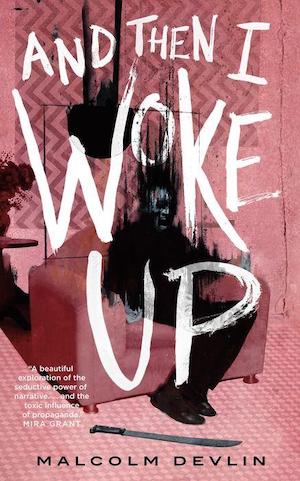

And Then I Woke Up
As with a lot of recent TV, the penultimate episode takes on a new angle, fills in a lot of backstory, and became so involving that I almost forgot that it was essentially an episode-length flashback. My one real issue with the show is just that in order to play it out over eight episodes, I think they stretched some of the believability—there are points where Melody and/or Dan stay in situations where any reasonable person would run as fast as their legs would carry them. The length also just leads to a few mushy sections in an otherwise beautifully tense show. All of the performances are great, with each Visser resident drawing on reserves of Hammer Horror Camp as they fuck with Melody’s head. In contrast to them, Ariana Neal is remarkably raw and honest as Jess, a fourteen-year-old Visserite who has grown up with these weirdos and suspects nothing.
Finally, and I promise you this is not a spoiler, but the last shot of the show is unhinged (in a good way) and I desperately hope we get a second season just so I can see where they go from the ending. And it would be wrong of me not to warn you—I talk a big game about how nothing scares me. I jump at our horror reviews. BUT. There’s a creepy song that becomes a motif in Archive 81 that hasn’t left my head for three days now, and I hate to admit this, but I’m a little freaked out by it? Almost frightened. Borderline scared. Which is both my way of recommending the show to you and also saying that if you hear I’ve disappeared to the Catskills, somebody come get me?
Leah Schnelbach needs more characters to say things like “The keys are in the Tarkovsky mug.” It gives them HOPE. Come hum creepy cult songs with them on Twitter!










